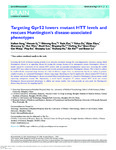Targeting Gpr52 lowers mutant HTT levels and rescues Huntington's disease-associated phenotypes.
| dc.contributor.author | Song, H | |
| dc.contributor.author | Li, H | |
| dc.contributor.author | Guo, S | |
| dc.contributor.author | Pan, Y | |
| dc.contributor.author | Fu, Y | |
| dc.contributor.author | Zhou, Z | |
| dc.contributor.author | Li, Z | |
| dc.contributor.author | Wen, X | |
| dc.contributor.author | Sun, X | |
| dc.contributor.author | He, B | |
| dc.contributor.author | Gu, H | |
| dc.contributor.author | Zhao, Q | |
| dc.contributor.author | Wang, C | |
| dc.contributor.author | An, P | |
| dc.contributor.author | Luo, Shouqing | |
| dc.contributor.author | Hu, Y | |
| dc.contributor.author | Xie, X | |
| dc.contributor.author | Lu, B | |
| dc.date.accessioned | 2018-04-17T09:02:59Z | |
| dc.date.issued | 2018-06-01 | |
| dc.identifier.issn | 0006-8950 | |
| dc.identifier.issn | 1460-2156 | |
| dc.identifier.uri | http://hdl.handle.net/10026.1/11280 | |
| dc.description.abstract |
See Huang and Gitler (doi:10.1093/brain/awy112) for a scientific commentary on this article.Lowering the levels of disease-causing proteins is an attractive treatment strategy for neurodegenerative disorders, among which Huntington's disease is an appealing disease for testing this strategy because of its monogenetic nature. Huntington's disease is mainly caused by cytotoxicity of the mutant HTT protein with an expanded polyglutamine repeat tract. Lowering the soluble mutant HTT may reduce its downstream toxicity and provide potential treatment for Huntington's disease. This is hard to achieve by small-molecule compound drugs because of a lack of effective targets. Here we demonstrate Gpr52, an orphan G protein-coupled receptor, as a potential Huntington's disease drug target. Knocking-out Gpr52 significantly reduces mutant HTT levels in the striatum and rescues Huntington's disease-associated behavioural phenotypes in a knock-in Huntington's disease mouse model expressing endogenous mutant Htt. Importantly, a novel Gpr52 antagonist E7 reduces mutant HTT levels and rescues Huntington's disease-associated phenotypes in cellular and mouse models. Our study provides an entry point for Huntington's disease drug discovery by targeting Gpr52. | |
| dc.format.extent | 1782-1798 | |
| dc.format.medium | ||
| dc.language | en | |
| dc.language.iso | en | |
| dc.publisher | Oxford University Press (OUP) | |
| dc.subject | GPCR | |
| dc.subject | target validation | |
| dc.subject | polyQ | |
| dc.subject | neurodegeneration | |
| dc.subject | antagonists | |
| dc.title | Targeting Gpr52 lowers mutant HTT levels and rescues Huntington's disease-associated phenotypes. | |
| dc.type | journal-article | |
| dc.type | Journal Article | |
| dc.type | Research Support, Non-U.S. Gov't | |
| plymouth.author-url | https://www.ncbi.nlm.nih.gov/pubmed/29608652 | |
| plymouth.issue | 6 | |
| plymouth.volume | 141 | |
| plymouth.publication-status | Published | |
| plymouth.journal | Brain | |
| dc.identifier.doi | 10.1093/brain/awy081 | |
| plymouth.organisational-group | /Plymouth | |
| plymouth.organisational-group | /Plymouth/Faculty of Health | |
| plymouth.organisational-group | /Plymouth/Faculty of Health/Peninsula Medical School | |
| plymouth.organisational-group | /Plymouth/REF 2021 Researchers by UoA | |
| plymouth.organisational-group | /Plymouth/REF 2021 Researchers by UoA/UoA01 Clinical Medicine | |
| plymouth.organisational-group | /Plymouth/Research Groups | |
| plymouth.organisational-group | /Plymouth/Research Groups/Institute of Translational and Stratified Medicine (ITSMED) | |
| plymouth.organisational-group | /Plymouth/Research Groups/Institute of Translational and Stratified Medicine (ITSMED)/CBR | |
| plymouth.organisational-group | /Plymouth/Users by role | |
| plymouth.organisational-group | /Plymouth/Users by role/Academics | |
| plymouth.organisational-group | /Plymouth/Users by role/Researchers in ResearchFish submission | |
| dc.publisher.place | England | |
| dcterms.dateAccepted | 2018-02-03 | |
| dc.rights.embargodate | 2018-6-15 | |
| dc.identifier.eissn | 1460-2156 | |
| dc.rights.embargoperiod | Not known | |
| rioxxterms.versionofrecord | 10.1093/brain/awy081 | |
| rioxxterms.licenseref.uri | http://www.rioxx.net/licenses/all-rights-reserved | |
| rioxxterms.licenseref.startdate | 2018-06-01 | |
| rioxxterms.type | Journal Article/Review | |
| plymouth.funder | Tackling autophagy and apoptosis for the potential therapy of Huntington's Disease::MRC |


